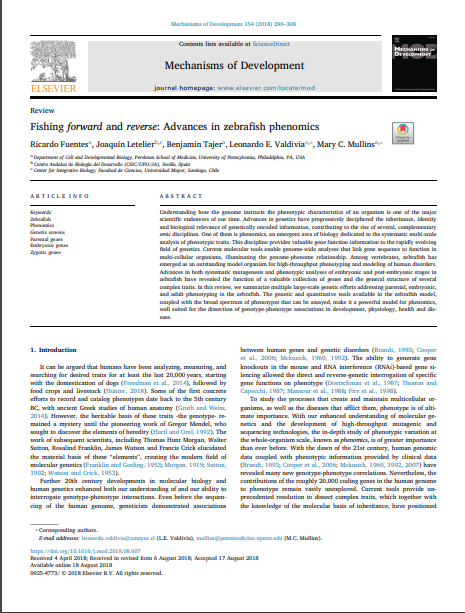Fishing forward and reverse: Advances in zebrafish phenomics

Fecha
2018Autor
Letelier, Joaquín [Univ Mayor, Fac Ciencias, Ctr Integrat Biol, Santiago, Chile]
Fuentes, Ricardo
Tajer, Benjamin
Mullins, Mary C.
Ubicación geográfica
Notas
HERRAMIENTAS
Acceda a títulos restringidos
¿Cómo descargar?Resumen
Understanding how the genome instructs the phenotypic characteristics of an organism is one of the major scientific endeavors of our time. Advances in genetics have progressively deciphered the inheritance, identity and biological relevance of genetically encoded information, contributing to the rise of several, complementary omic disciplines. One of them is phenomics, an emergent area of biology dedicated to the systematic multi-scale analysis of phenotypic traits. This discipline provides valuable gene function information to the rapidly evolving field of genetics. Current molecular tools enable genome-wide analyses that link gene sequence to function in multi-cellular organisms, illuminating the genome-phenome relationship. Among vertebrates, zebrafish has emerged as an outstanding model organism for high-throughput phenotyping and modeling of human disorders. Advances in both systematic mutagenesis and phenotypic analyses of embryonic and post-embryonic stages in zebrafish have revealed the function of a valuable collection of genes and the general structure of several complex traits. In this review, we summarize multiple large-scale genetic efforts addressing parental, embryonic, and adult phenotyping in the zebrafish. The genetic and quantitative tools available in the zebrafish model, coupled with the broad spectrum of phenotypes that can be assayed, make it a powerful model for phenomics, well suited for the dissection of genotype-phenotype associations in development, physiology, health and disease.
Coleccion/es a la/s que pertenece:
Si usted es autor(a) de este documento y NO desea que su publicación tenga acceso público en este repositorio, por favor complete el formulario aquí.